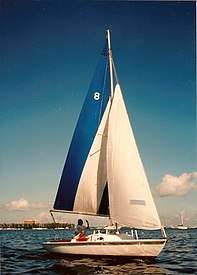Pearson Ensign
The Pearson Ensign is an American sailboat that was designed by Carl Alberg as a one-design racer and day sailer and first built in 1962. It is the largest full-keel one-design keelboat class in the United States.[1][2][3][4]
 Class symbol | |
 | |
| Development | |
|---|---|
| Designer | Carl Alberg |
| Location | United States |
| Year | 1962 |
| No. built | 1776 |
| Builder(s) | Pearson Yachts, Ensign Spars |
| Boat | |
| Boat weight | 3,000 lb (1,361 kg) |
| Draft | 3.00 ft (0.91 m) |
| Hull | |
| Type | Monohull |
| Construction | Fiberglass |
| LOA | 22.50 ft (6.86 m) |
| LWL | 16.75 ft (5.11 m) |
| Beam | 7.00 ft (2.13 m) |
| Engine type | Outboard motor |
| Hull appendages | |
| Keel/board type | long keel |
| Ballast | 1,200 lb (544 kg) |
| Rudder(s) | keel-mounted rudder |
| Rig | |
| Rig type | Bermuda rig |
| I (foretriangle height) | 25.00 ft (7.62 m) |
| J (foretriangle base) | 7.50 ft (2.29 m) |
| P (mainsail luff) | 25.42 ft (7.75 m) |
| E (mainsail foot) | 11.08 ft (3.38 m) |
| Sails | |
| Sailplan | Fractional rigged sloop |
| Mainsail area | 140.83 sq ft (13.084 m2) |
| Jib/genoa area | 93.75 sq ft (8.710 m2) |
| Total sail area | 234.58 sq ft (21.793 m2) |
The Ensign is a development of the Pearson Electra.[1]
Production
The design was built by Pearson Yachts of Bristol, Rhode Island and later by Ensign Spars of Dunedin, Florida, both in the United States. A total of 1776 examples were completed, but the design is now out of production.[1][5]
Development
The Ensign was developed from the Alberg-designed Electra. The Electra design was a commission by Pearson Yachts in 1959 to produce a Midget Ocean Racing Club (MORC) racer. The resulting design was quite successful and about 350 were completed during its six-year production run. Pearson's dealers thought that customers would prefer a design with a bigger cockpit and less space below decks for use in one-design racing and day sailing. Alberg designed the Ensign using the same hull, but with the mast moved 6 in (15 cm) forward, a larger mainsail and smaller fore-triangle.[1]
The resulting design was initially called the Electra Day Sailor and 219 examples were sold in 1962, the first year of production. In 1963, 213 more boats were produced.[1]
Design
The Ensign is a recreational keelboat, built predominantly of fiberglass, with balsawood cores and wood trim. It has a fractional sloop rig, a spooned raked stem, a raised reverse transom, a keel-mounted rudder controlled by a tiller and a fixed long keel. The only class-permitted mast adjustment while sailing is the backstay which is controlled by a turnbuckle. The boat displaces 3,000 lb (1,361 kg) and carries 1,200 lb (544 kg) of ballast.[1][4]
The cuddy cabin has two berths and may be fitted with an optional stove. The cabin has headroom of 3 ft 10 in (117 cm). The cockpit is 8 ft 8 in (264 cm) and features a teak wood sole, coamings and seats.[4]
The boat has a draft of 3.00 ft (0.91 m) with the standard long keel fitted.[1]
The boat is normally fitted with a small outboard motor for docking and maneuvering.[1]
The design has a hull speed of 5.48 kn (10.15 km/h).[6]
Operational history
Racing fleets were first formed when the design entered production, in 1962. The first fleet was formed in Larchmont, New York. By 1963 nine more fleets had been formed, with locations in Houston, Texas; Hingham, Massachusetts; Providence, Rhode Island; Huntington, New York, Port Washington, New York; Miami, Florida; Gibson Island, Maryland and Falmouth, Maine.[1]
By 1994 there were 47 fleets sailing in 20 US states.[4]
American Sailboat Hall of Fame
The Ensign was inducted into the now-defunct Sail America American Sailboat Hall of Fame in 2002. In honoring the design the hall cited, "She is rarely the belle of the ball. In fact, some hotshots have even been known to call Ensigns 'tubby' as they go zipping by in their dripping-wet performance dinghies. But a funny thing tends to happen when sailors stop to take a closer look at this long lived one-design racer and family daysailer. They notice the old girl is more attractive than they thought. In fact, she's got some pretty nice curves. Before they know it they're in love. ... Stable, comfortable, maybe a bit plain, the Ensign nonetheless has a deep-seated quality that inevitably shines through. No doubt the boat will be taking families and racers sailing for generations to come."[7]
See also
Related design
Similar sailboats
References
- Browning, Randy (2019). "Ensign (Pearson) sailboat specifications and details". sailboatdata.com. Retrieved 3 January 2019.
- Browning, Randy (2019). "Pearson Yachts". sailboatdata.com. Retrieved 3 January 2019.
- Browning, Randy (2018). "Carl Alberg". sailboatdata.com. Retrieved 3 January 2019.
- Sherwood, Richard M.: A Field Guide to Sailboats of North America, Second Edition, page 116-117. Houghton Mifflin Company, 1994. ISBN 0-395-65239-1
- Ensign Spars (2018). "Products". ensignspars.com. Retrieved 3 January 2019.
- InterVisionSoft LLC (2019). "Sailboat Specifications for Pearson Ensign". Sailing Joy. Retrieved 3 January 2019.
- Sail America. "Ensign". www.sailamerica.com. Archived from the original on 12 February 2013. Retrieved 3 January 2019.
External links
